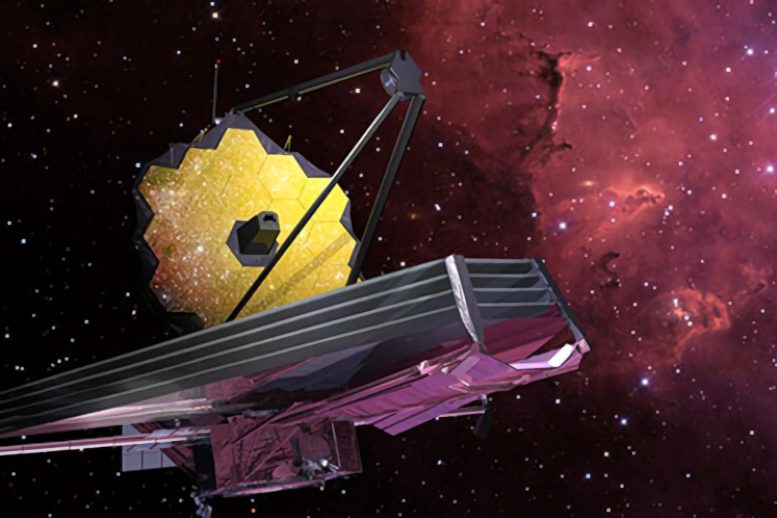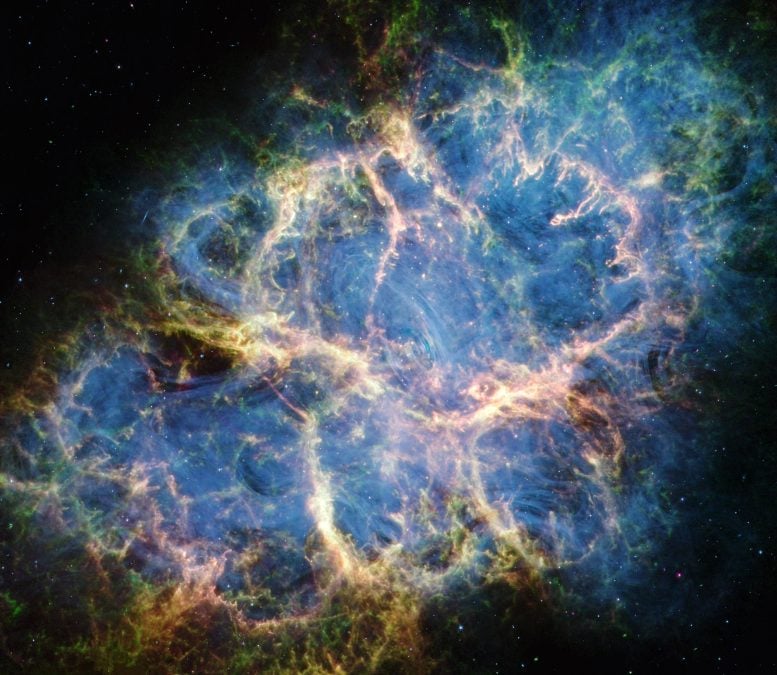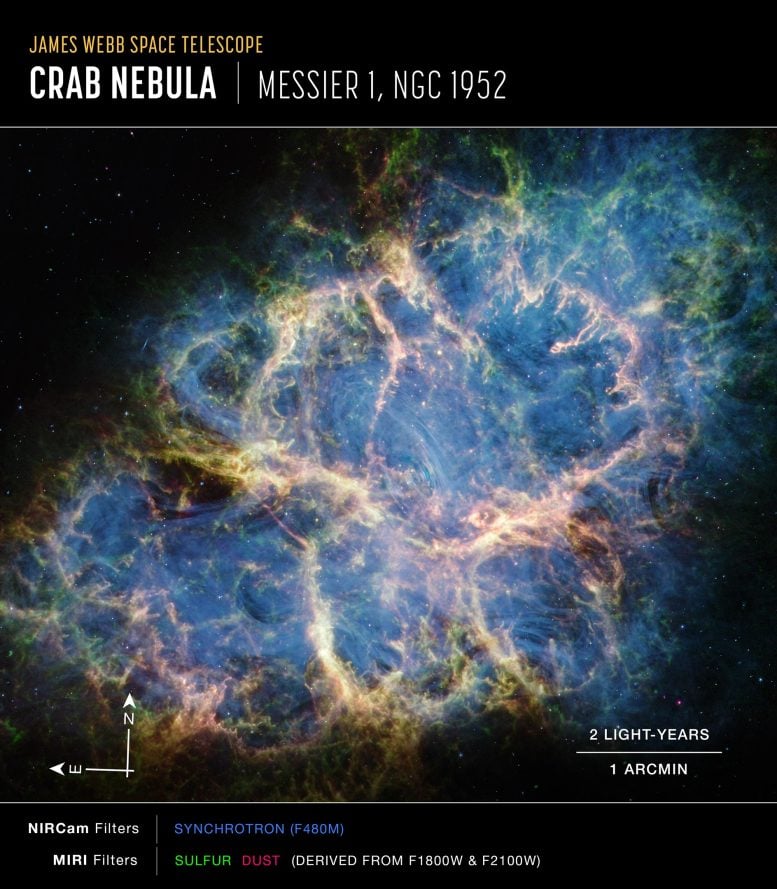Webb Space Telescope Rewrites the Origin Story of the Crab Nebula’s Supernova


NASA’s James Webb Space Telescope dissected the Crab Nebula’s structure, aiding astronomers as they continue to evaluate leading theories about the supernova remnant’s origins. With the data collected by Webb’s NIRCam (Near-Infrared Camera) and MIRI (Mid-Infrared Instrument), a team of scientists were able to closely inspect some of the Crab Nebula’s major components. Credit: NASA
New data revises our view of this unusual supernova explosion.
The Crab Nebula is a nearby example of the debris left behind when a star undergoes a violent death in a supernova explosion. However, despite decades of study, this supernova remnant continues to maintain a degree of mystery: What type of star was responsible for the creation of the Crab Nebula, and what was the nature of the explosion?
NASA’s James Webb Space Telescope has provided a new view of the Crab, including the highest-quality infrared data yet available to aid scientists as they explore the detailed structure and chemical composition of the remnant. These clues are helping to unravel the unusual way that the star exploded about 1,000 years ago.

For the first time ever, astronomers mapped the warm dust emission throughout this supernova remnant. Represented as fluffy magenta material, the dust grains form a cage-like structure that is most apparent toward the lower left and upper right portions of the remnant. Filaments of dust are also threaded throughout the Crab’s interior and sometimes coincide with regions of doubly ionized sulfur (sulfur III) colored in green. Yellow-white mottled filaments, which form large loop-like structures around the supernova remnant’s center, represent areas where dust and doubly ionized sulfur overlap.
The dust’s cage-like structure helps constrain some, but not all of the ghostly synchrotron emission represented in blue. The emission resembles wisps of smoke, most notable toward the Crab’s center. The thin blue ribbons follow the magnetic field lines created by the Crab’s pulsar heart — a rapidly rotating neutron star.
Credit: NASA, ESA, CSA, STScI, Tea Temim (Princeton University)
Investigating the Origins of the Crab Nebula With the Webb Space Telescope
Using NASA’s James Webb Space Telescope, a team of scientists parsed the composition of the Crab Nebula, a supernova remnant located about 6,500 light-years away in the constellation Taurus. With the telescope’s MIRI (Mid-Infared Instrument) and NIRCam (Near-Infrared Camera), the team gathered data that is helping to clarify the Crab Nebula’s history.
The Crab Nebula is the result of a core-collapse supernova from the death of a massive star. The supernova explosion itself was seen on Earth in 1054 CE and was bright enough to view during the daytime. The much fainter remnant observed today is an expanding shell of gas and dust, and outflowing wind powered by a pulsar, a rapidly spinning and highly magnetized neutron star.
The Crab Nebula is also highly unusual. Its atypical composition and very low explosion energy previously have been explained by an electron-capture supernova — a rare type of explosion that arises from a star with a less-evolved core made of oxygen, neon, and magnesium, rather than a more typical iron core.
“Now the Webb data widen the possible interpretations,” said Tea Temim, lead author of the study at Princeton University in New Jersey. “The composition of the gas no longer requires an electron-capture explosion, but could also be explained by a weak iron core-collapse supernova.”

Image of the Crab Nebula captured by Webb’s NIRCam and MIRI, with compass arrows, scale bar, and color key for reference.
The north and east compass arrows show the orientation of the image on the sky. Note that the relationship between north and east on the sky (as seen from below) is flipped relative to direction arrows on a map of the ground (as seen from above).
The scale bar is labeled in light-years, which is the distance that light travels in one Earth-year. (It takes 2 years for light to travel a distance equal to the length of the bar.) One light-year is equal to about 5.88 trillion miles or 9.46 trillion kilometers. The field of view shown in this image is approximately 10 light-years across.
This image shows invisible near-infrared and mid-infrared wavelengths of light that have been translated into visible-light colors. The color key shows which components were observed by NIRCam and MIRI, and which visible-light color is assigned to each feature.
Credit: NASA, ESA, CSA, STScI, Tea Temim (Princeton University)
Studying the Present to Understand the Past
Past research efforts have calculated the total kinetic energy of the explosion based on the quantity and velocities of the present-day ejecta. Astronomers deduced that the nature of the explosion was one of relatively low energy (less than one-tenth that of a normal supernova), and the progenitor star’s mass was in the range of eight to 10 solar masses — teetering on the thin line between stars that experience a violent supernova death and those that do not.
However, inconsistencies exist between the electron-capture supernova theory and observations of the Crab, particularly the observed rapid motion of the pulsar. In recent years, astronomers have also improved their understanding of iron core-collapse supernovae and now think that this type can also produce low-energy explosions, providing that the stellar mass is adequately low.
Webb Measurements Reconcile Historic Results
To lower the level of uncertainty surrounding the Crab’s progenitor star and nature of the explosion, the team led by Temim used Webb’s spectroscopic capabilities to hone in on two areas located within the Crab’s inner filaments.
Theories predict that because of the different chemical composition of the core in an electron-capture supernova, the nickel to iron (Ni/Fe) abundance ratio should be much higher than the ratio measured in our Sun (which contains these elements from previous generations of stars). Studies in the late 1980s and early 1990s measured the Ni/Fe ratio within the Crab using optical and near-infrared data and noted a high Ni/Fe abundance ratio that seemed to favor the electron-capture supernova scenario.
The Webb telescope, with its sensitive infrared capabilities, is now advancing Crab Nebula research. The team used MIRI’s spectroscopic abilities to measure the nickel and iron emission lines, resulting in a more reliable estimate of the Ni/Fe abundance ratio. They found that the ratio was still elevated compared to the Sun, but only modestly and much lower in comparison to prior estimates.
The revised values are consistent with electron-capture, but do not rule out an iron core-collapse explosion from a similarly low-mass star. (Higher-energy explosions from higher-mass stars are expected to produce ratios closer to solar abundances.) Further observational and theoretical work will be needed to distinguish between these two possibilities.
“At present, the spectral data from Webb covers two small regions of the Crab, so it’s important to study much more of the remnant and identify any spatial variations,” said Martin Laming of the Naval Research Laboratory in Washington and a co-author of the paper. “It would be interesting to see if we could identify emission lines from other elements, like cobalt or germanium.”
Mapping the Crab’s Current State
Besides pulling spectral data from two small regions of the Crab Nebula’s interior to measure the abundance ratio, the telescope also observed the remnant’s broader environment to understand details of the synchrotron emission and the dust distribution.
The images and data collected by MIRI enabled the team to isolate the dust emission within the Crab and map it in high resolution for the first time. By mapping the warm dust emission with Webb, and even combining it with the Herschel Space Observatory’s data on cooler dust grains, the team created a well-rounded picture of the dust distribution: The outermost filaments contain relatively warmer dust, while cooler grains are prevalent near the center.
“Where dust is seen in the Crab is interesting because it differs from other supernova remnants, like Cassiopeia A and Supernova 1987A,” said Nathan Smith of the Steward Observatory at the University of Arizona and a co-author of the paper. “In those objects, the dust is in the very center. In the Crab, the dust is found in the dense filaments of the outer shell. The Crab Nebula lives up to a tradition in astronomy: The nearest, brightest, and best-studied objects tend to be bizarre.”
These findings have been published in The Astrophysical Journal Letters.
Reference: “Dissecting the Crab Nebula with JWST: Pulsar Wind, Dusty Filaments, and Ni/Fe Abundance Constraints on the Explosion Mechanism” by Tea Temim, J. Martin Laming, P. J. Kavanagh, Nathan Smith, Patrick Slane, William P. Blair, Ilse De Looze, Niccolò Bucciantini, Anders Jerkstrand, Nicole Marcelina Gountanis, Ravi Sankrit, Dan Milisavljevic, Armin Rest, Maxim Lyutikov, Joseph DePasquale, Thomas Martin, Laurent Drissen, John Raymond, Ori D. Fox, Maryam Modjaz, Anatoly Spitkovsky and Louis-Gregory Strolger, 13 June 2024, The Astrophysical Journal Letters.
DOI: 10.3847/2041-8213/ad50d1
The observations were taken as part of General Observer program 1714.
The James Webb Space Telescope (JWST) is an advanced space observatory launched on December 25, 2021. It serves as the scientific successor to the Hubble Space Telescope. Equipped with a large 6.5-meter primary mirror and specialized instruments, JWST operates primarily in the infrared spectrum, allowing it to look further back in time and observe the first galaxies that formed after the Big Bang. Positioned at the second Lagrange point (L2), about 1.5 million kilometers from Earth, it provides unprecedented resolution and sensitivity, enabling scientists to study every phase of cosmic history.


